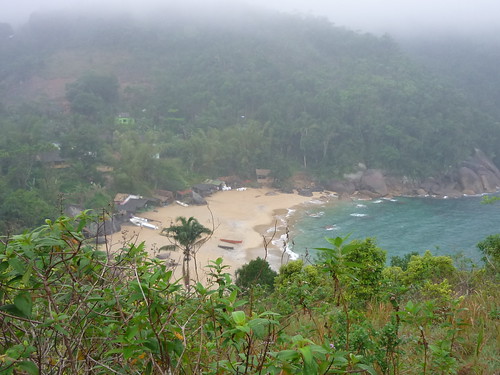There are two main reasons that I’ve been writing less since I arrived in Trindade (on the green coast of Rio state). First is the fact that being in a small fishing village with rainforests on all sides and a plethora of beaches doesn’t make sitting down and spending a good portion of the day on the internet a tempting option. The second is cachaça. This is the national drink of Brazil, and is used to make caipirinhas, a cocktail made from mixing cachaça, lime, sugar and ice, and which is increasingly becoming popular in other countries. This is reflected in the price, with caipirinhas sold in the bars of Rio, Sao Paulo and any-other tourist-leaning city for upto 15 or 20 Reais, which is about 5 pounds, and ridiculously over-priced. Until 1990 cachaça and caipirinhas were both drinks primarily of the working class. The word caipirinha is derived from the word caipira, which means something along the lines of country bumpkin in portuguese. After that point brewers started making artesanal cachaças by aging the drink (made by distilling sugarcane, in a similar process to most brandies) in wooden casks, giving the alcohol a deeper flavour as well as colouring it a golden brown. In addition, the rising popularity of caipirinhas in the United States meant that exports became a lot more common and that visitors were more aware of this drink, which was now available in pretty much every bar you can find in Brazil.
http://www.flickr.com/photos/64738468@N00/3146602528/
To buy a bottle of unaged cachaça will set you back around 5 Reais. Considering you can then get around 20 or more caipirinhas from that bottle it’s no surprise that bars are more than willing to bask in its popularity and sell it for 15 Reais a glass. Drinking cachaça in this way is only the tip of the iceberg though. Since arriving in Trindade I’ve discovered far more ways in which people enjoy it. It’s not too surprising that this village would be so steeped in the drink, it’s an hour’s bus journey from Paraty, a place generally seen as some kind of cachaça capital. The drink was in fact actually known as paraty before its other titles of cachaça and pinga (which is more common here) were introduced. In addition, they hold the Pinga Festival every August where a mountain of artesanal cachaças and cachaças flavoured with all kinds of fruits and spices are available as shots from hundreds of vendors on the street.
http://www.flickr.com/photos/jonnycocker/2852010952/
My current poison and reason for spending many daylight hours flat out when I really should be doing something more productive is Gabriela. This is cachaça infused with honey, cloves and cinnamon. Thanks to these spices it does have something of the mulled wine about it and it most certainly warms up the stomach. I’ve also been told that in the south of Brazil they drink a very similar thing which they serve hot (I’m guessing on those days when the temperature is only 15 degrees or someting). There’s a bar on Praia dos Ranchos here in Trindade, called Rogerio’s, who only plays vinyl records, all of which are from the 70s and 80s. Nights spent drinking Gabriela and listening to scratchy Led Zeppelin and Supertramp records have becoming something quite legendary, at least in my eyes anyway!
Another great tipple is Pinga com Mel, which is quite simply cachaça with honey. Even stronger than gabriela but half the price at just 2 Reais a glass (that’s less than one pound) it’s too strong for me to drink solidly. I prefer a beer by the side just to take the edge off every now and again.
http://www.flickr.com/photos/lperdigao/172905311/
There is something that will always appeal to me about these drinks over the over-priced caipirinhas. It seems simple to me. If you want a caipirinha then you buy a bottle of cachaça and a few limes and make your own, and if you want to drink what the people drink, then you look for the shoddy-looking old water machine in the corner, or the jerry can with a price on the side, to get a taste of what the people actually drink, and also get a little bit fuzzy in the mouth at the same time.





